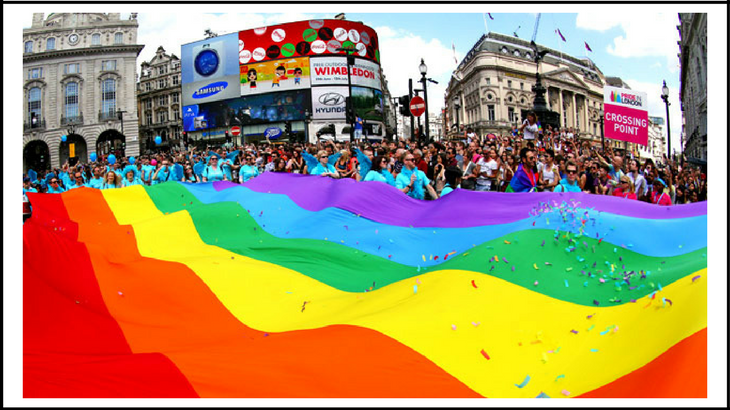End restrictions on numbers, make Pride a march for LGBT+ rights
By Peter Tatchell
London, UK – 18 November 2019
Responding to the Pride London community consultation about the future of the parade, Peter Tatchell said:
“I thank Pride London and everyone who contributed their opinions.
“As a Patron of Pride and one of the organisers of the UK’s first Pride in 1972, I have attended every parade since then – 47 in all.
I believe a major rethink is needed. We need to get back to what Pride was originally about.
I propose a one-year trial as follows:
The Pride parade should become a march for LGBT+ rights
As a political march, this would mean no charges being imposed by Westminster Council, the Metropolitan Police and the Greater London Authority, saving around £60,000 in fees to Westminster Council alone.
Pride should be open to all
There should be no restriction on the number of people who can march and no requirement to get a wristband.
Oppressive institutions should be excluded from Pride sponsorship & the parade
This includes weapons manufacturers, tobacco and fossil fuel companies and the Home Office until it stops incarcerating, banning employment and deporting LGBT+ refugees. Individuals from these institutions should still be welcome in the parade but without any corporate branding.
Ban motorised floats, except for disability vehicles
Having vehicles in the parade allows Westminster Council to slap onerous charges on Pride and contributes to the carbon emissions that fuel climate destruction.
“I am proposing that these ideas be trialled for one-year in 2020. If they work, Pride can keep them permanently. If not, Pride can ditch them and try something new.
“The founding principles of the LGBT+ Pride parade in 1972 were: LGBT+ visibility, the celebration of LGBT+ life and culture and the demand for LGBT+ liberation, including the abolition of discriminatory laws and reform of anti-LGBT+ institutions. It was open to all who supported these core principles.
“The Pride parade can and should remain true to its founding ideals.
“Pride must be by and for the LGBT+ community – not city authorities or corporate funders. Their support is welcome but it must not dictate.
“Pride has become too corporate and commercial. Businesses are increasingly dominating and overshadowing grassroots community groups. Some corporate presence and funding is fine. But we need to strike a better balance between corporates, community groups and individuals in the parade. LGBT+ people and our liberation cause – in the UK and globally – must be the main focus and presence.
“The aim of the parade should be to improve the visibility, profile and impact of LGBT+ people and causes – especially the unfinished battle for LGBT+ human rights.
“The Mayor of London, Westminster council and the Metropolitan Police now hold the whip-hand. The Pride parade operates on their terms – not ours.
“We must reject any cap on numbers in the parade. It goes against the ethos of Pride which was, until recent years, open to all. In 1997, there were over 100,000 people in the parade and 300,000 at the post-parade festival on Clapham Common. Numbers are not everything but they should not be artificially restricted.
“The parade needs to have a section for individuals, where anyone can just turn up and join in, as they do at political marches.
“Pride has become depoliticised at a time when there are still LGBT+ rights to fight for in this country and worldwide. In 2019, I counted only a handful of groups in the parade that had a specific human rights message.
“Bland, anodyne Pride themes should be ditched in favour of explicit LGBT+ human rights ones, with two or three specific, concrete human rights demands each year. This way Pride can become a champion of our rights and freedoms, as it was originally. And a clear and strong human rights message will increase the likelihood of valuable media coverage.
What an alternative model for the Pride parade might look like:
“Revert to a political carnival parade for LGBT rights, like the first one in 1972. If it is a political march there would be no fees payable to the police, council etc.
“Political marches are not charged. The anti-austerity and anti-Brexit marches were not subject to any of the draconian costs and restrictions on numbers that have been imposed on Pride.
“Pride can be political and still have a colourful, joyous carnival atmosphere, as in 1972 and 1997.
“To cut parade costs, motorised floats should be axed and replaced by other options, such as hand-pulled non-motorised floats – mounted on flatbeds on wheels – as some groups had in 1997. These were smaller in size than the gigantic bus and truck floats of recent years but still fabulous and more diverse and imaginative eg the OutRage! giant papier mache head of Tony Blair in Pride 1998. The Thames Festival parade is awesome but has no motorised floats. I remember a huge dragon held aloft by dozens of parade participants using tall poles. It was very effective and dramatic; proving that motorised floats are not the only way to have a spectacular carnival parade.
“My congratulations and thanks to the Pride organisers, the Community Advisory Board and all the volunteers who make Pride in London possible. Pride’s online consultation seeking LGBT+ input regarding the future of the parade was commendable. I salute you,” said Peter Tatchell.

